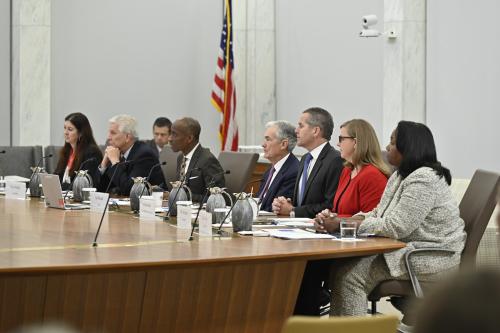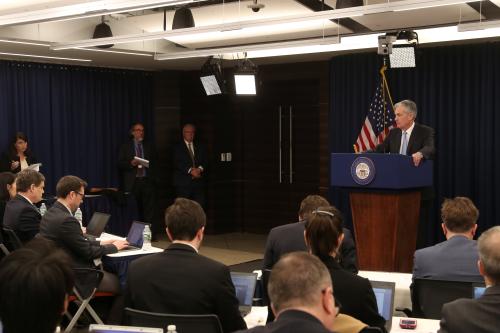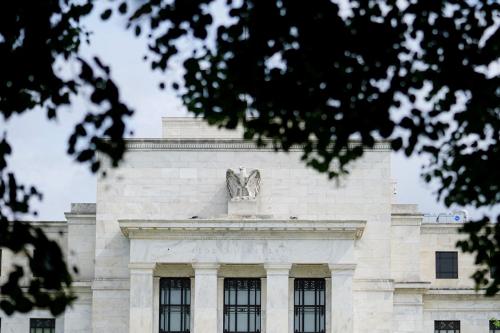Since the financial crisis the Federal Reserve has aggressively used monetary policy, including unconventional policies like quantitative easing, to promote job growth and keep inflation near the Fed’s 2 percent target. Progress has been made, even if it has been slower than we would have liked. Unemployment, which peaked at 10 percent in 2009, is now 5.4 percent and falling, and inflation appears gradually to be moving toward its target.
Early critics of the Fed’s policies warned that they would be ineffective; or, if effective, that they would generate high inflation and the collapse of the dollar. With these forecasts largely discredited, critics have turned to other arguments. In this post I’ll look at another critique, that the Fed’s monetary policies have exacerbated inequality—a proposition that happens to be the subject of a June 1 symposium at the Brookings Institution’s Hutchins Center on Fiscal and Monetary Policy.
The claim that Fed policy has worsened inequality usually begins with the (correct) observation that monetary easing works in part by raising asset prices, like stock prices. As the rich own more assets than the poor and middle class, the reasoning goes, the Fed’s policies are increasing the already large disparities of wealth in the United States.
Certainly, inequality and lack of social mobility are issues of first-order significance for economic policy in general. Should they also be first-order considerations for the making of monetary policy? I have my doubts.
First, widening inequality is a very long-term trend, one that has been decades in the making. The degree of inequality we see today is primarily the result of deep structural changes in our economy that have taken place over many years, including globalization, technological progress, demographic trends, and institutional change in the labor market and elsewhere. By comparison to the influence of these long-term factors, the effects of monetary policy on inequality are almost certainly modest and transient. (Most economists would agree that monetary policy is “neutral” or nearly so in the longer term, meaning that it has limited long-term effects on “real” outcomes like the distribution of income and wealth.)
Second, monetary policy, if properly managed, promotes greater economic stability and prosperity for the economy as a whole, by mitigating the effects of recessions on the labor market and keeping inflation low and stable. Even if it were true that the aggregate economic gains from effective monetary policies are unequally distributed (more below), that would not be a reason to forego such policies. Rather, the right response is to rely on other types of policies to address distributional concerns directly, such as fiscal policy (taxes and government spending programs) and policies aimed at improving workers’ skills. Policies designed to affect the distribution of wealth and income are, appropriately, the province of elected officials, not the Fed. Alternatively, if fiscal policymakers took more of the responsibility for promoting economic recovery and job creation, monetary policy could be less aggressive.
These two general points would hold even if monetary policy had clear and easily discernable distributional effects. In fact, the distributional effects of monetary policy are complex and uncertain. In particular, while it is true both that easy monetary policy raises stock prices and that stocks are disproportionately held by the wealthy, it does not follow that, overall, the Fed’s recent monetary policies have disadvantaged the poor and middle class relative to the rich. Here are a few countervailing factors:
- Perhaps most important, easier monetary policies promote job creation as well as increases in asset prices. A stronger labor market—more jobs at better wages—obviously benefits the middle class, and it is the best weapon we have against poverty. At the Hutchins Center conference, the paper by Josh Bivens concludes that positive employment effects are “by far the largest impact of monetary policy changes on inequality” (p. 6). If the average working person were given the choice of the status quo (current Fed policies) and a situation with both a weaker labor market and lower stock prices (tighter Fed policies), which would he or she choose?
- The rich have more assets than the middle class (the poor have almost no assets, real or financial), but the middle class is not without assets whose values rise during a period of easy money. Most obviously, more than sixty percent of families own their home. Nontraded equity, such as an ownership stake in a small business, is also an important asset for many families, one that also benefits from a general increase in asset prices and an improving economy.
- All else equal, debtors tend to benefit (and creditors lose) from higher inflation, which reduces the real value of debts. Debtors are generally poorer than creditors, so on this count easier monetary policy again reduces inequality. (Higher inflation hurts those who rely relatively more on cash in their transactions, a group that is poorer than average; at current inflation rates, however, this effect is very small.) To be clear, the Fed is not aiming for high inflation or to wipe out debts. But its efforts to hit its 2 percent inflation target are good for debtors, relative to the alternative of allowing inflation to drift below target or even morph into deflation. Debtors are also made better off by low interest rates, all else equal. For example, homeowners benefit when they can refinance their mortgage at a lower rate.
- Stock prices have risen rapidly over the past six years or so, but they were also severely depressed during and just after the financial crisis. Arguably, the Fed’s actions have not led to permanent increases in stock prices, but instead have returned them to trend. To illustrate: From the end of the 2001 recession (2001:q4) through the pre-crisis business cycle peak (2007:q4), the S&P500 stock price index grew by about 1.2 percent a quarter. If the index had grown at that same rate from the fourth quarter of 2007 on, it would have averaged about 2123 in the first quarter of this year; its actual value was 2063, a little below that. There are of course many ways to calculate the “normal” level of stock prices, but most would lead to a similar conclusion.
Interestingly, some of the same critics who say that the Fed’s policies disproportionately help the wealthy also claim that they “hurt savers” by lowering rates of return. Since the wealthy tend to be savers, and the middle class and poor tend to be borrowers, the assertions that Fed policy helps the wealthy and hurts savers cannot generally both be true.
The two claims could be reconciled if middle-income savers count primarily on interest income while high-income savers have more diversified portfolios, which seems plausible. Recent research by Anthony Webb and Richard Kopcke of Boston College’s Center for Retirement Research confirms that retirees in the middle and upper middle classes (third and fourth wealth quintiles) are more exposed than others to declines in interest income, as we would expect. However, when Webb and Kopcke compare the post-crisis year 2011 to pre-crisis 2007, they find that the reduction in this group’s investment income (including interest) generally amounted to less than 10 percent of their total income (including Social Security, pensions, and the like). As a share of total income, losses in investment income from 2007 to 2011 were actually greatest for retirees the highest wealth quintile. More generally, the Fed’s Survey of Consumer Finances finds that, across all income classes, interest-bearing accounts make up less than 5 percent of total household wealth. This is consistent with the observation that, in the national income accounts, personal interest income (excluding imputations) is usually between 5 and 10 percent of personal income.
The low return on savings has imposed significant hardship in numerous individual cases, a fact that I do not mean to minimize. A weak economy hurts many people, in many ways. But, in the aggregate, these effects do not appear big enough to move the needle with respect to overall inequality.
Monetary policy is a blunt tool which certainly affects the distribution of income and wealth, although whether the net effect is to increase or reduce inequality is not clear. More research will be needed to untangle and measure the many channels through which these effects are transmitted. But the (uncertain) distributional impact of monetary policy should not prevent the Fed from pursuing its mandate to achieve maximum employment and price stability, thereby providing broad benefits to the economy. Other types of policies are better suited to addressing legitimate concerns about inequality.
Comments are now closed for this post.
The Brookings Institution is committed to quality, independence, and impact.
We are supported by a diverse array of funders. In line with our values and policies, each Brookings publication represents the sole views of its author(s).



Commentary
Monetary policy and inequality
June 1, 2015